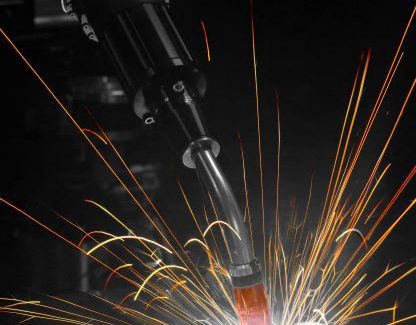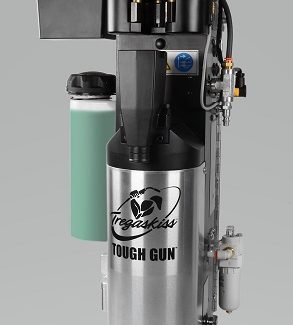Five Tips for Robotic Welding Process and Project Planning
Planning for a robotic welding project should focus on the process and the specific project. After following these tips, conduct a trial to gauge problems before you start full production.
Posted: October 13, 2021
WELDING TIPS
By Justin Craft
Robotic welding projects can arise in several ways — from a smaller shop expanding its capabilities to a large original equipment manufacturer (OEM) awarding new business or even a new company establishing itself within the competitive landscape.
Regardless of the circumstances, it’s critical to implement a well-thought-out and thoroughly researched plan to ensure a successful robotic welding operation. The plan should cover both the details related to the welding process and the specific project at hand. This helps companies meet quality and productivity goals while maintaining their cost margins and achieving profitability.
Being proactive is the key with planning. Doing so helps minimize the opportunity for unforeseen risks that could be detrimental to the welding operation. Some basic tips can help along the way.
1. Ask questions
To determine the desired outcome for a robotic welding operation, it’s important to define the welding process — in terms of how efficient and quick it needs to be — and to consider all details related to the project’s budget. Asking some fundamental questions can help stakeholders define the scope of the process they are using and the project they are undertaking.
- What efficiencies do we need from the welding process?
- How labor-intensive will the process be?
- Is there adequate staff for loading/unloading fixtures?
- What training will staff need to keep the robot welding effectively?
- How many robots do we need? And how hard or long do we want the robots to work?
- What should we consider about the weld cell ergonomics?
- How should the robots be configured?
- What capital is available and how fast do we want our return on investment (ROI) to be?
Answering these questions can help companies as they plan out their project and conduct cost analysis.
2. Set realistic goals
Along with asking questions to set the foundation for solid process and project planning, it’s also important to set realistic goals. These goals should relate to general processes in the robotic weld cell along with desired quality outcomes.
For example, when considering the capabilities of the welding process in a robotic cell, a 75-to-80 percent efficiency rate may be a realistic goal. No welding process is 100 percent efficient, so it’s important to account for equipment downtime (planned or unplanned), consumable changeover, welding wire drum changeover and more.
The same holds true for quality goals. Having 100 percent quality isn’t necessarily true to life because weld defects like porosity can occur, tool center point (TCP) can shift and stampings can become misaligned. Each of these instances is possible (and probable) in an everyday robotic welding operation.
Setting realistic goals allows time for unexpected occurrences once the robotic welding system is at work.
3. Look at the long term
While it may be tempting for companies to look for ways to reduce upfront costs during process and project planning, this doesn’t ensure that the long-term results are always positive. For example, neglecting to consider (and purchase) supplemental equipment, such as reamers (also called nozzle cleaning stations), can lead to greater expenses over the lifetime of a project.
Reamers clean spatter from the welding gun nozzle and gas diffuser to ensure smooth shielding gas flow that in turn supports good weld quality. Reamers are available in analog or ethernet models.
It’s important to consider reamer quality, especially for heavy-duty, higher-volume applications. While reamers with heavy-duty construction generally cost more, they also last much longer than light-duty models. Be sure to size the reamer appropriately for the project because reamers vary in the amount of torque they provide when removing spatter. Heavy-duty reamers provide more torque and have cutter blades that can reach deeper into the nozzle for a more thorough spatter cleaning.
Companies should also determine how much human interaction with the reamer is necessary to keep the welding process at target efficiency levels. For example, implementing a multi-feed anti-spatter sprayer system reduces time and labor for refilling the small sprayer reservoir on the reamer. It can feed multiple reamers from a large drum of anti-spatter solution outside the weld cell.
4. Pay attention to the small details
When it comes to identifying equipment for a robotic welding cell, it may be easy to overlook the importance of robotic MIG guns and consumables. While small in investment compared to a robot, each can have a significant impact on the efficiency of a welding process and the quality of the project.
Frequent changeover due to poor-quality MIG welding consumables or ones that aren’t appropriate for the application can add up. Be sure to select those that will be compatible with the heat inputs. Brass nozzles are strong and better able to resist spatter adhesion than copper nozzles. However, brass can be brittle at high temperatures, so they are best for lower-heat applications. Copper nozzles are better for high-heat applications but tend to allow greater spatter adhesion. For pulsed applications, where waveforms can be especially harsh on contact tips, an HDP tip can last longer, reducing the frequency of downtime caused by tip changes. The same holds true for contact tips that offer coarse threads to reduce the risk of cross-threading during replacement. When possible, standardize consumables throughout the entire welding operation to bring greater efficiencies.
Like consumables, the robotic MIG gun selected needs to match the duty cycle of the application to withstand the resistive heat and avoid overheating. The gun should also have an appropriate size of neck for the application to enable access to tooling and the weld joint.
5. Look for opportunities to optimize
Finding ways to maximize robot uptime is an important part of process and project planning. Robots are expensive, so companies want to be sure that they will get as close to 100 percent optimization as possible.
Having a high-quality welding wire, like a metal-cored wire, that supports faster travel speeds is one option to help optimize the robotic welding system. Look for wires with a consistent cast and helix to support smooth wire feeding.
Preventive maintenance (PM) programs help ensure that a robotic welding system operates efficiently, avoids unplanned downtime and supports more arc-on time. With a preventive maintenance schedule, companies can proactively check and change welding gun liners and MIG welding consumables during planned downtime, while also assessing the power cable and robot for damage.
It’s also important to plan for the ways that employees can support robot optimization. Training is critical. Properly trained robotic welding supervisors or technicians can be more effective at understanding the process and adjusting equipment as needed. Appropriate training can also help them run the equipment longer and more efficiently.
PUTTING EVERYTHING TO WORK
Once a company considers the key tips for process and project planning, they should be sure that everything works. Trials can help flush out unforeseen problems before starting full production and save money by preventing budget overages to fix issues.
After a project has been put into motion, take time for reflection. Revisit all aspects to see what worked and what didn’t. Continuing to learn from projects can help companies achieve future success.













